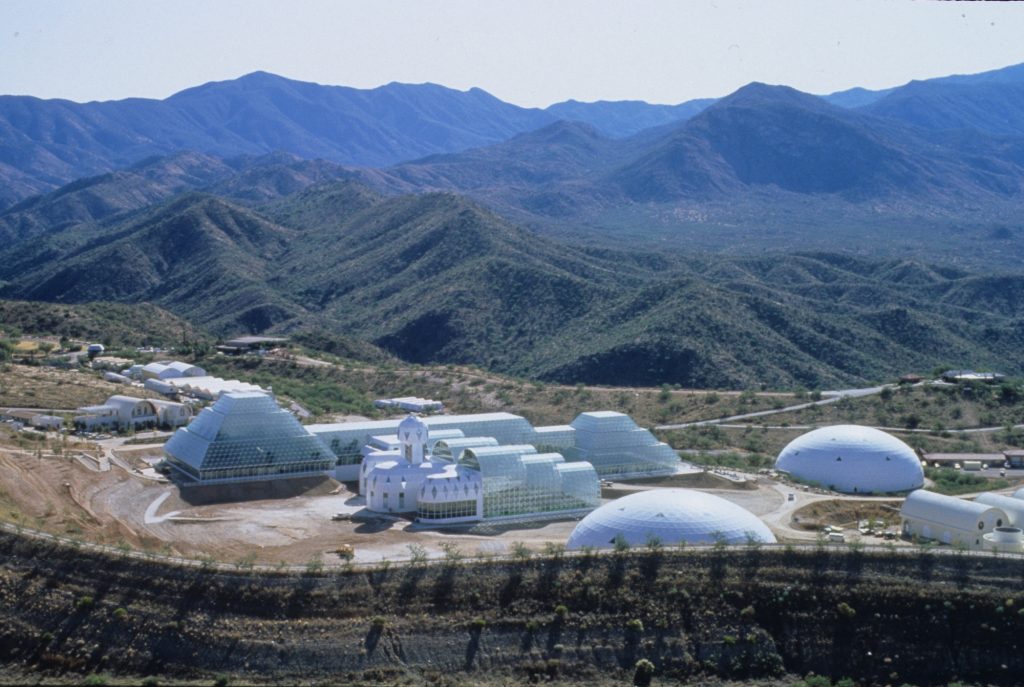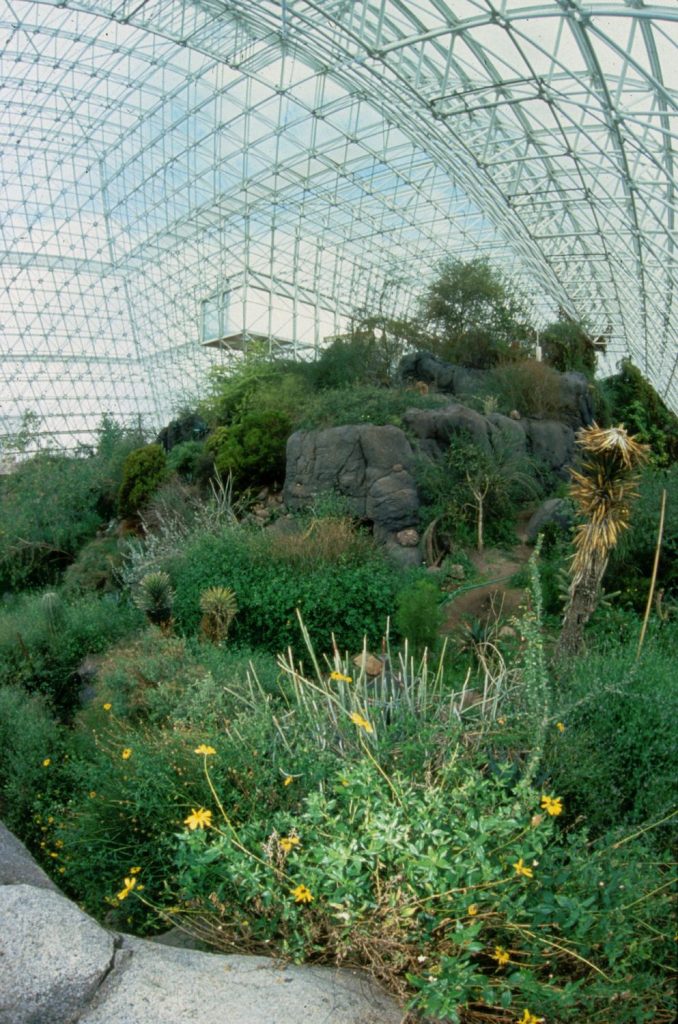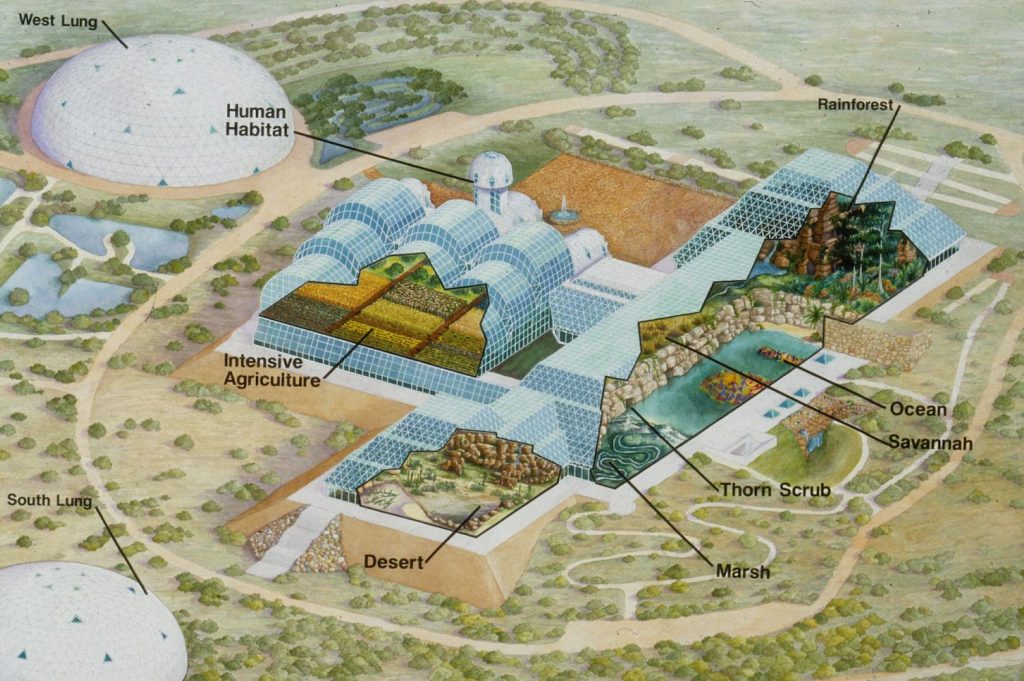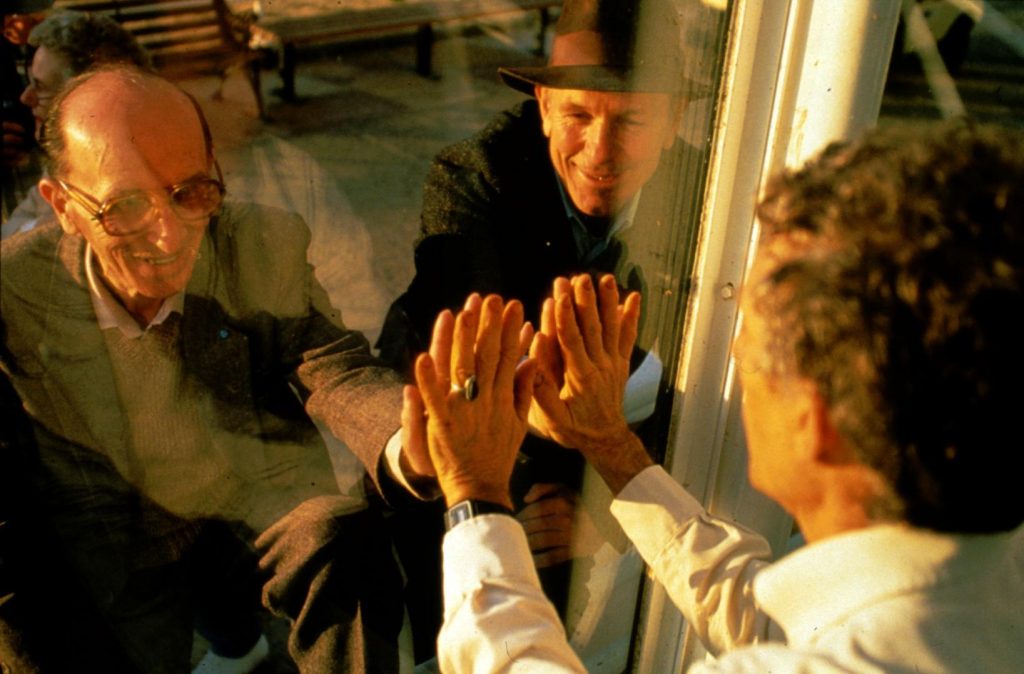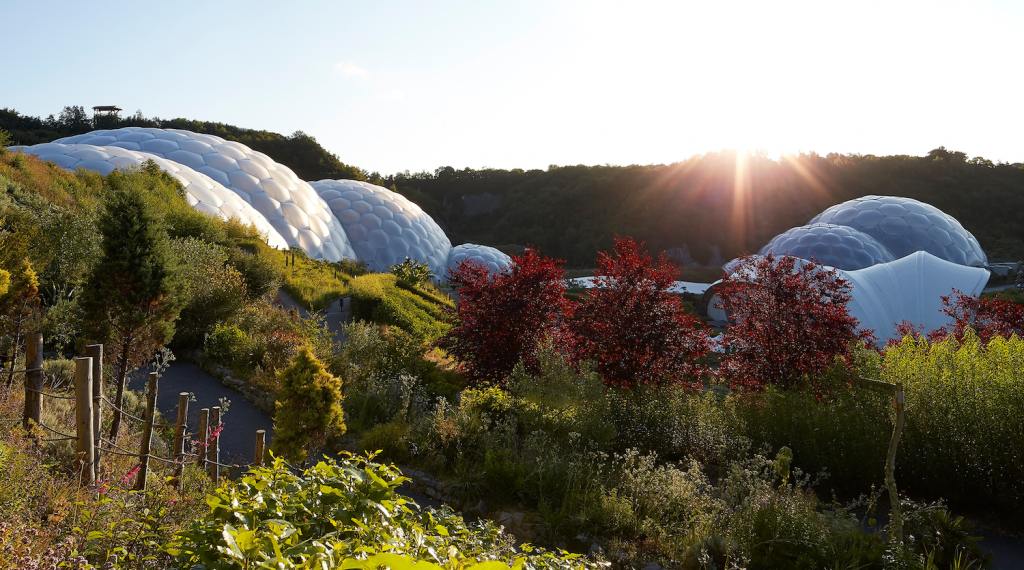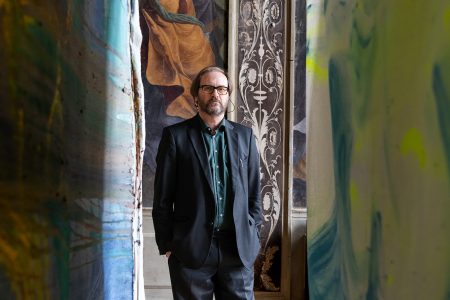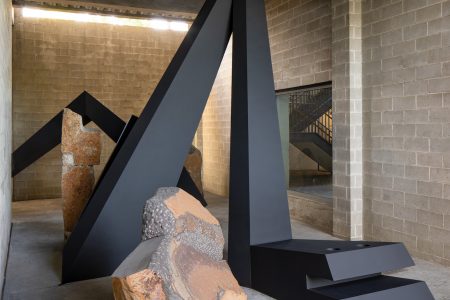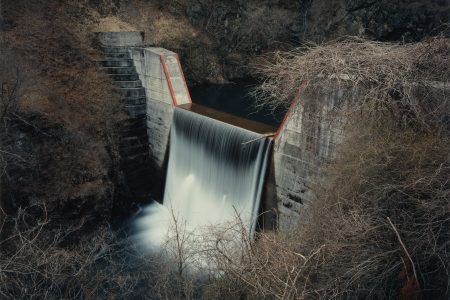The Origins and Legacy of Biosphere 2
For TLmag36: All Is Landscape, guest editor, Bas Smets, invited author and activist, Kathelin Gray, to write about her experience and connections to the Biosphere 2, an experimental and ambitious project about the earth and climate change.
One of the enduring legacies of the Biosphere 2 experiment is empowering the young and visionary to tackle projects of epic scale. It was an impossibly ambitious project, built with a sense of urgency to address a planetary train wreck, one which the world is in the midst of now.
Motivated by the extremity of social inequity and humanity’s disastrous War on Nature, Biosphere 2 inventor John Allen had a vision of a new civilisation. It would be an organisation based on science, elements of traditional practices and cutting edge artistic explorations. “Synergetic Civilisation” would cultivate a respectful and balanced relationship with other species, with humans as stewards. This civilisation would be bite-sized, comprising a series of small groups. If others were inspired by the activities, they were free to borrow what they liked.
I was a teenager in the late 1960s when John and I, and 8 other like-minded dreamers, dropouts and doers moved in together, commune-style. Different ages, different backgrounds, we formed Enterprise for Developing Possibilities, and Theatre of All Possibilities, a scrappy interdisciplinary touring ensemble that was 100% participatory and where everyone did everything from cooking and washing the dishes, to repairing roofs and fixing the tour bus. Through theatre study, we researched our motivations and emotions, as well as cultural histories, strengths and biases.
What motivated our workaholic productivity was the realisation that civilisation had to change in order to avoid a planetary-wide ecological catastrophe within a matter of decades, and to create a context for social justice – an issue that belongs with ecology.
We figured that we could responsibly proceed through small groups, testing small scale, practical projects. If we succeeded, our work could inspire others. If not, no harm done and we gave it our best try. A growing group, we spent decades setting up and operating projects around the world, one in each biome. It has been outrageously challenging to keep such an enterprise going and to persist in the gruelling work of long term collaboration. John had a background in geology (Colorado School of Mines). In the 1980s, a friend introduced us to an un- published manuscript of an English translation of Soviet biogeochemist Vladimir Vernadsky’s 1924 paper, The Biosphere, which concluded that life is a geologic force. Vernadsky had had a Tesla-like revelation one day when he looked up and saw a great flock of birds flying over- head. I like to think that a bird turd landed on his head like Newton’s apple, prompting his insight that the nitrogen-rich excrement would be concentrated in migration paths. At that moment, Vernadsky realised that life transforms and transports matter throughout the world. On reading the paper, John had his own epiphany. His habitual napkin scribblings of new civilisations and space colonies became diagrams of natural and artificial biospheres. The rest of our team was excited; there were no real studies of complex life systems, nor was ecology a developed science, nor did NASA or other active space programs have any real initiatives to create life support systems for space travel. With scientific alliances we had developed over decades, we formulated a unified biosphere conceptual design. We had support from founders of systems ecology, as well as key biologists, microbiologists, engineers, architects and others. A long-time colleague who for over a decade had been a co- owner and integral participant in all our biomic projects committed the funding, and off we went. In 1985, we created a company to develop ecological research chambers for universities, green technology, and, as a spinoff, could develop life systems for space. A former conference centre outside of Tucson, Arizona, was purchased. Biosphere 2 encapsulated (literally) our decades of ground truth experience. We engaged over 200 scientists and engineers to assist in creating first, a one-person Test Module, then the epic scale 1.27 hectare, hermetically sealed, Biosphere 2. It was an outrageously ambitious venture: the previous closed life system had been as big as a closet.
Simulations fall short in earth’s profoundly complex life systems; instead we wanted to provide a way for controlled, real time observation of what had only been observed in detail in the field. Our first experiment in Biosphere 2 was meant to be the first of 100 years of experiments to understand how nature works as a system, i.e., to establish the first laboratory for the new science of biospherics, a test tube for ecology. The crew were stewards and we would also study the long-term effects of anthropogenic intervention.
Instead of looking out a window and viewing a landscape, the primarily glass structure enabled outsiders to view the multi-biome, populated landscape inside. A critical difference in our approach over other “closed life support systems” was we focussed on soil, rather than hydroponics or aquaponics. Biosphere 2 was the inverse of the blue marble which imaged the planet from a great techno enabled distance. Instead, B2 demonstrated an experience in which the experimenter participates as an integral element in the experiment with dirt under their fingernails, growing their own food and tending to their world. It is also the opposite of Google Earth; it is mapping turned on its head. The initial experiment in 1991 was 2 years, with eight crew, “Biospherians”. They were, by the beginning of the experiment, not only trained in being generalists, looking at the synergistic whole and familiar with specialist fields, but trained in theatre workshops. When they emerged in 1993 after the successful conclusion of the 2 year experiment, each expressed a profound impact from two years of conscious interdependency. John Allen had conceived of Biosphere 2 closed system experiment as an analogue to Earth’s biosphere (Biosphere 1). A laboratory environment of a certain scale large enough for complex life systems was necessary to establish a new science of Biospherics. Biosphere 2 was energetically and informationally open, and materially closed. It was so sealed that the structure required “lungs”, i.e., variable pressure chambers connected to the main structure, to allow for heat expansion and contraction as air temperature varied. We could have no toxic substances inside as all air and water were recycled. We could not deploy solar panels, as in 1991 the expense far outweighed the benefits. We had our own energy pro- duction centre. The invention of a specially-engineered hermetic seal (above and below ground) for the huge structure that contained 7 connected representative terrestrial biomes, allowed precise tracking of the molecules inside. B2 was to serve as a laboratory for an ongoing 100-year-long experiment, studying natural adjustments and compensations. Each plant had a sensor; light levels and atmospheric chemistry were also tracked.
Our bonsai biosphere contained bonsai biomes, all designed for subtropical temperature average, the “wilderness biomes” – a mini desert, wetlands, ocean, cloud forest, tropical forest, savannah, and the “anthropogenic biomes”– agriculture and the urban biome where crew members lived. Underneath the footprint of the biomes was a “technosphere” that contained mechanical and computational equipment that operated Biosphere 2: pumps, wave machines, filtration systems, cooling pumps, wind generation, computer controls, etc. In the urban biome were apartments, a common kitchen, workout area, the first paperless office, and a gorgeous library. The eight Biospherians maintained and operated the entire thing inside, in consultation with Mission Control. They were researchers, medical officer, composters, large animals for the savannah, repairmen, farmers (they grew their own), and media liaisons.
Mission Control, exterior to the B2 structure, housed administrative and monitoring stations for the sensors within. An agricultural bay, called Biospheric Research and Design Complex (BRDC) provided a staging area for flora.
The entire team, inside and out, lived through years of joys, dilemmas, successes, glitches. It was a Kitty Hawk for biospherics, a test run, and there was to be 98 years of further experiments. The second experiment in 1994 consisted of 7 crew members. They grew 100% of their food and didn’t experience the hunger that the first crew had as the agricultural system light levels and crops had been tweaked. The second experiment, which is rarely referred to, was interrupted after 10 months in by a corporate takeover from our partner. By now, the ownership and direction has been passed onto University of Arizona, who is doing less ambitious, but nevertheless important research. I always tell John, who is now 92, that even though Biosphere 2 is not what the team had initially dreamed, a laboratory for biospheric science, it nevertheless actually got built! – and 2 manned experiments were successfully conducted. And now, it is a functioning research and education centre, and a land- mark that has all but achieved the level of myth.
The rare level of ambition and audacity of Biosphere 2 has resulted in an important legacy of experimental projects. The B2 multi-biome approach inspired Sir Tim Smit when he founded the Eden Project in Cornwall. B2 also influenced the Lunar Palace in Beijing, CEEF Closed ecological experimental facility (Mini-Earth) in Rokkasho Japan, NASA’s Hi-SEAS in Hawaii, the Amazon headquarters in Seattle, and recently, Bas Smets’s Parc des Ateliers in Arles France. And, finally going full circle, Biosphere 2’s influence is honoured in the facility itself, where newly-vibrant experiments addressing climate dilemmas are being researched. Joaquin Ruiz, dean of the College of Science at the University of Arizona, who now oversees Biosphere 2, states “Because of its scale, there is no other facility like it. We like to say that the Biosphere 2 was built before its time,” Ruiz said. “But now, it has become one of the best places to study the effects of climate change.”
